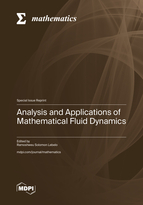Analysis and Applications of Mathematical Fluid Dynamics
A special issue of Mathematics (ISSN 2227-7390). This special issue belongs to the section "Mathematical Physics".
Deadline for manuscript submissions: closed (30 September 2023) | Viewed by 22442
Special Issue Editor
Interests: computational fluid dynamics; heat mass transfer
Special Issues, Collections and Topics in MDPI journals
Special Issue Information
Dear Colleagues,
Fluid dynamics studies deal with fluid flow in fluid mechanics. Fluids may be categorized into three forms, namely, liquids, gases, and plasma. Plasma is ionized gas, and much of the universe is thought to consist of plasma. It is often applied in galaxy information and modern plasma television. The study of fluid dynamics has attracted many researchers because of its widespread applications, including, among others, for biological and medical purposes, flow rate and velocity, Bernoulli’s equation: pressure and speed, Poiseuille’s equation and viscosity, blood flow, surface tension, molecular transport phenomena, pumps, and the heart. In addition to the abovementioned research areas, fluid mechanics covers aerodynamics, which is concerned with the study of air in motion, whose applications, among others, include finding and calculating forces acting on airplanes and the design of airplane wings.
This Special Issue aims to bring together academics, engineers, researchers, and scientists to share recent ideas, methods, trends, problems, and solutions in the following areas:
- Applied, computational, and mathematical physics;
- Combustion and decomposition theories;
- Computational thermal engineering;
- Heat and mass transfer;
- Magnetohydrodynamics (MHD);
- Mechanics of fluids.
Dr. Ramoshweu Solomon Lebelo
Guest Editor
Manuscript Submission Information
Manuscripts should be submitted online at www.mdpi.com by registering and logging in to this website. Once you are registered, click here to go to the submission form. Manuscripts can be submitted until the deadline. All submissions that pass pre-check are peer-reviewed. Accepted papers will be published continuously in the journal (as soon as accepted) and will be listed together on the special issue website. Research articles, review articles as well as short communications are invited. For planned papers, a title and short abstract (about 100 words) can be sent to the Editorial Office for announcement on this website.
Submitted manuscripts should not have been published previously, nor be under consideration for publication elsewhere (except conference proceedings papers). All manuscripts are thoroughly refereed through a single-blind peer-review process. A guide for authors and other relevant information for submission of manuscripts is available on the Instructions for Authors page. Mathematics is an international peer-reviewed open access semimonthly journal published by MDPI.
Please visit the Instructions for Authors page before submitting a manuscript. The Article Processing Charge (APC) for publication in this open access journal is 2600 CHF (Swiss Francs). Submitted papers should be well formatted and use good English. Authors may use MDPI's English editing service prior to publication or during author revisions.
Keywords
- applied, computational, and mathematical physics
- combustion and decomposition theories
- computational thermal engineering
- heat and mass transfer
- magnetohydrodynamics (MHD)
- mechanics of fluids






